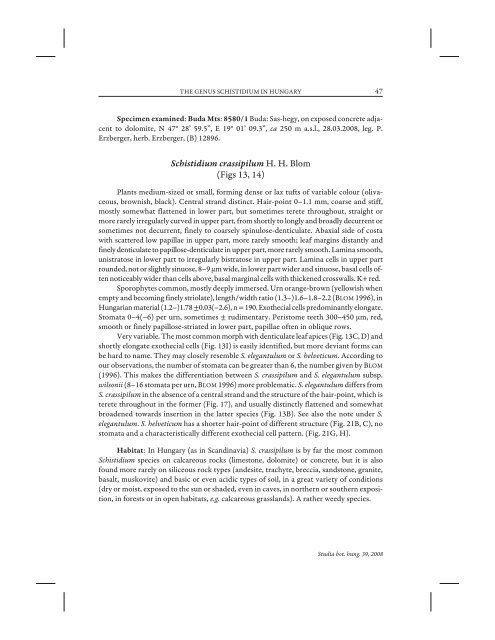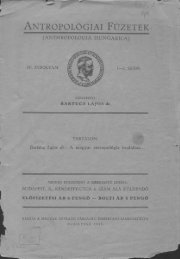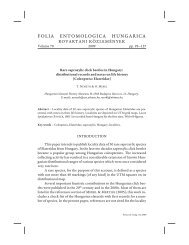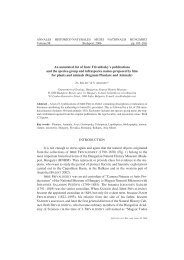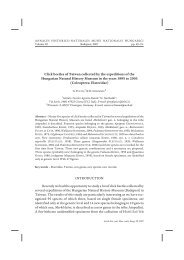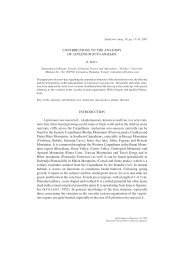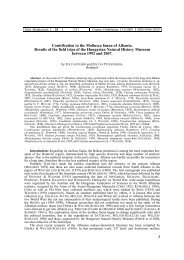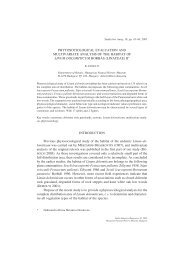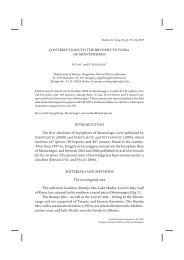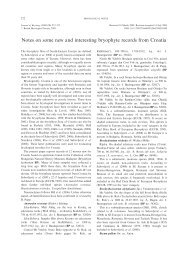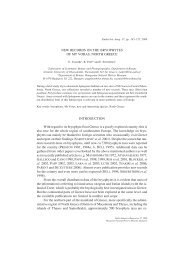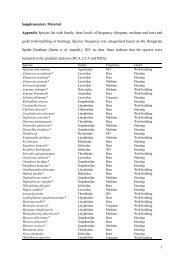THE GENUS SCHISTIDIUM (GRIMMIACEAE, MUSCI) IN HUNGARY ...
THE GENUS SCHISTIDIUM (GRIMMIACEAE, MUSCI) IN HUNGARY ...
THE GENUS SCHISTIDIUM (GRIMMIACEAE, MUSCI) IN HUNGARY ...
Create successful ePaper yourself
Turn your PDF publications into a flip-book with our unique Google optimized e-Paper software.
<strong>THE</strong> <strong>GENUS</strong> <strong>SCHISTIDIUM</strong> <strong>IN</strong> <strong>HUNGARY</strong> 47<br />
Specimen examined: Buda Mts: 8580/1 Buda: Sas-hegy, on exposed concrete adjacent<br />
to dolomite, N 47° 28’ 59.5”, E 19° 01’ 09.3”, ca 250 m a.s.l., 28.03.2008, leg. P.<br />
Erzberger, herb. Erzberger, (B) 12896.<br />
H. H. Blom<br />
(Figs 13, 14)<br />
Plants medium-sized or small, forming dense or lax tufts of variable colour (olivaceous,<br />
brownish, black). Central strand distinct. Hair-point 0–1.1 mm, coarse and stiff,<br />
mostly somewhat flattened in lower part, but sometimes terete throughout, straight or<br />
more rarely irregularly curved in upper part, from shortly to longly and broadly decurrent or<br />
sometimes not decurrent, finely to coarsely spinulose-denticulate. Abaxial side of costa<br />
with scattered low papillae in upper part, more rarely smooth; leaf margins distantly and<br />
finely denticulate to papillose-denticulate in upper part, more rarely smooth. Lamina smooth,<br />
unistratose in lower part to irregularly bistratose in upper part. Lamina cells in upper part<br />
rounded, not or slightly sinuose, 8–9 μm wide, in lower part wider and sinuose, basal cells often<br />
noticeably wider than cells above, basal marginal cells with thickened crosswalls. K+ red.<br />
Sporophytes common, mostly deeply immersed. Urn orange-brown (yellowish when<br />
empty and becoming finely striolate), length/width ratio (1.3–)1.6–1.8–2.2 (BLOM 1996), in<br />
Hungarian material (1.2–)1.78 ±0.03(–2.6), n = 190. Exothecial cells predominantly elongate.<br />
Stomata 0–4(–6) per urn, sometimes ± rudimentary. Peristome teeth 300–450 μm, red,<br />
smooth or finely papillose-striated in lower part, papillae often in oblique rows.<br />
Very variable. The most common morph with denticulate leaf apices (Fig. 13C, D) and<br />
shortly elongate exothecial cells (Fig. 13I) is easily identified, but more deviant forms can<br />
be hard to name. They may closely resemble S. elegantulum or S. helveticum. According to<br />
our observations, the number of stomata can be greater than 6, the number given by BLOM<br />
(1996). This makes the differentiation between S. crassipilum and S. elegantulum subsp.<br />
wilsonii (8–16 stomata per urn, BLOM 1996) more problematic. S. elegantulum differs from<br />
S. crassipilum in the absence of a central strand and the structure of the hair-point, which is<br />
terete throughout in the former (Fig. 17), and usually distinctly flattened and somewhat<br />
broadened towards insertion in the latter species (Fig. 13B). See also the note under S.<br />
elegantulum. S. helveticum has a shorter hair-point of different structure (Fig. 21B, C), no<br />
stomata and a characteristically different exothecial cell pattern. (Fig. 21G, H).<br />
:InHungary(asinScandinavia)S. crassipilum is by far the most common<br />
Schistidium species on calcareous rocks (limestone, dolomite) or concrete, but it is also<br />
found more rarely on siliceous rock types (andesite, trachyte, breccia, sandstone, granite,<br />
basalt, muskovite) and basic or even acidic types of soil, in a great variety of conditions<br />
(dry or moist, exposed to the sun or shaded, even in caves, in northern or southern exposition,<br />
in forests or in open habitats, e.g. calcareous grasslands). A rather weedy species.<br />
Studia bot. hung. 39, 2008


